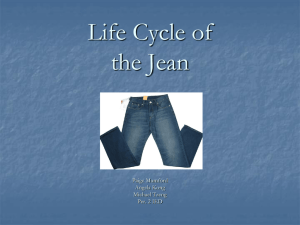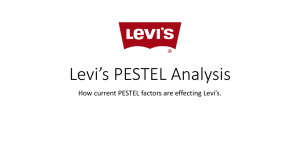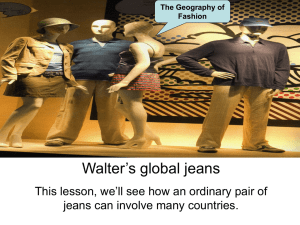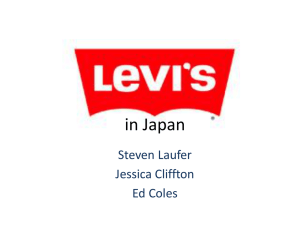The Jeaning of America – And the World
advertisement
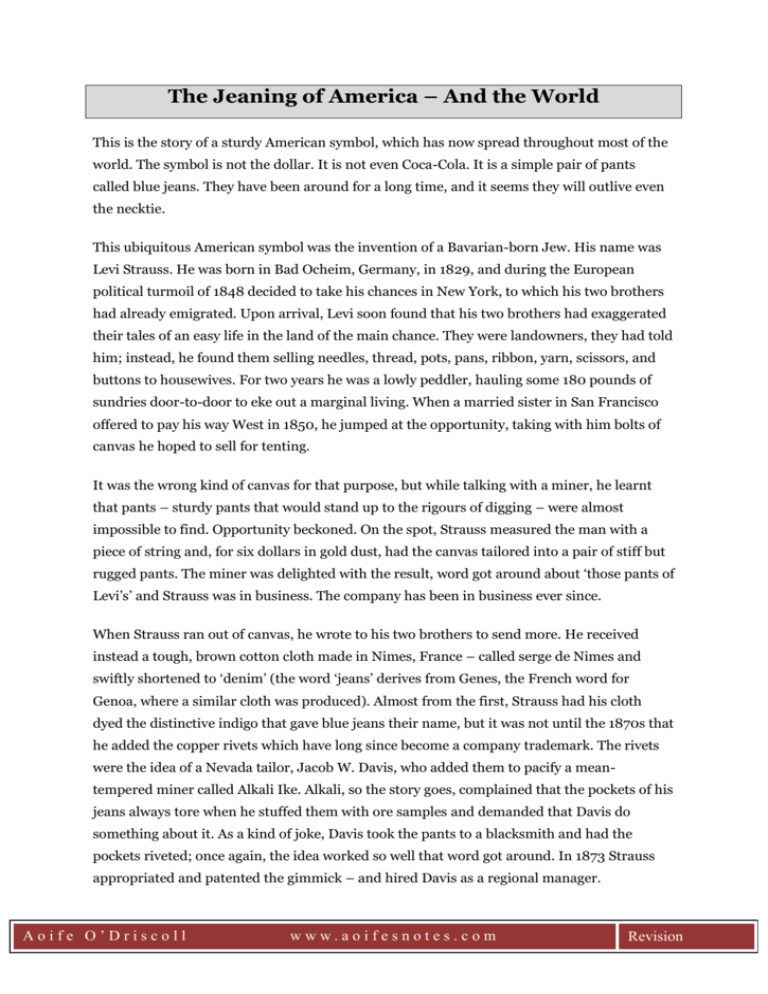
The Jeaning of America – And the World This is the story of a sturdy American symbol, which has now spread throughout most of the world. The symbol is not the dollar. It is not even Coca-Cola. It is a simple pair of pants called blue jeans. They have been around for a long time, and it seems they will outlive even the necktie. This ubiquitous American symbol was the invention of a Bavarian-born Jew. His name was Levi Strauss. He was born in Bad Ocheim, Germany, in 1829, and during the European political turmoil of 1848 decided to take his chances in New York, to which his two brothers had already emigrated. Upon arrival, Levi soon found that his two brothers had exaggerated their tales of an easy life in the land of the main chance. They were landowners, they had told him; instead, he found them selling needles, thread, pots, pans, ribbon, yarn, scissors, and buttons to housewives. For two years he was a lowly peddler, hauling some 180 pounds of sundries door-to-door to eke out a marginal living. When a married sister in San Francisco offered to pay his way West in 1850, he jumped at the opportunity, taking with him bolts of canvas he hoped to sell for tenting. It was the wrong kind of canvas for that purpose, but while talking with a miner, he learnt that pants – sturdy pants that would stand up to the rigours of digging – were almost impossible to find. Opportunity beckoned. On the spot, Strauss measured the man with a piece of string and, for six dollars in gold dust, had the canvas tailored into a pair of stiff but rugged pants. The miner was delighted with the result, word got around about ‘those pants of Levi’s’ and Strauss was in business. The company has been in business ever since. When Strauss ran out of canvas, he wrote to his two brothers to send more. He received instead a tough, brown cotton cloth made in Nimes, France – called serge de Nimes and swiftly shortened to ‘denim’ (the word ‘jeans’ derives from Genes, the French word for Genoa, where a similar cloth was produced). Almost from the first, Strauss had his cloth dyed the distinctive indigo that gave blue jeans their name, but it was not until the 1870s that he added the copper rivets which have long since become a company trademark. The rivets were the idea of a Nevada tailor, Jacob W. Davis, who added them to pacify a meantempered miner called Alkali Ike. Alkali, so the story goes, complained that the pockets of his jeans always tore when he stuffed them with ore samples and demanded that Davis do something about it. As a kind of joke, Davis took the pants to a blacksmith and had the pockets riveted; once again, the idea worked so well that word got around. In 1873 Strauss appropriated and patented the gimmick – and hired Davis as a regional manager. Aoife O’Driscoll w w w. a o i f e s n o t e s . c o m Revision The company went from strength to strength and today more than two hundred and fifty million items of Levi’s clothing are sold every year – including more than eighty-three million pairs of riveted blue jeans. They have become through marketing, word of mouth, and demonstrable reliability, the common pants of America. The jeans have become a tradition, and along the way have acquired a history of their own – so much so that the company has opened a museum in San Francisco. There was, for example, the turn-of-thecentury trainman who replaced a faulty coupling with a pair of jeans; the Wyoming man who used his jeans as a tow rope to haul his car out of a ditch; the Californian who found several pairs in an abandoned mine, wore them, then discovered they were sixty-three years old and still as good as new and turned them over to the Smithsonian Institute as a tribute to their toughness. And then there was the particularly terrifying story of the careless construction worker who dangled fifty-two storeys above the street until rescued; his sole support the Levi’s belt hoop through which his rope was hooked. Aoife O’Driscoll w w w. a o i f e s n o t e s . c o m Revision 1. From your reading of the passage what sort of person do you think Levi Strauss was? Note: I have underlined and highlighted the key words in the question above. The words ‘what sort of person’ tell us that this is a question on character. Therefore, in the answer, it is vital to use words to describe character. Remember: make a point, explain it, and support it with evidence from the passage. Words which describe character. Levi Strauss seems to have been an adventurous, outgoing type of person. He emigrated to America when he was only nineteen years of age, which shows that he was not afraid to take a chance in his quest for a new life. Equally, when he got an opportunity to go to the West Coast of America, he seized the chance and Evidence from text. headed off to try his luck in a different part of the country. I am making a new point, here, so I move on to a new paragraph. He was clearly hard-working too; when he discovered that his brothers in New York had been exaggerating their wealth and importance, he buckled down to work as a ‘lowly peddler’. Leaving New York after a couple of years, he headed west with bolts of canvas, obviously prepared to use them to make what living he could. Levi Strauss seems to have had an entrepreneurial spirit and an open mind, both of which contributed to his business success. He listened to a miner complaining about the impossibility of finding sturdy, reliable trousers and instantly took the man's measurements and made him a Points are backed up with evidence from the passage. pair of tough, canvas pants. Equally, when a tailor jokingly added rivets to the pocket seams to placate a grumpy customer, Strauss saw the sense in the idea and when it caught on, hired the tailor as his regional manager. It was the combination of all of these traits which, I believe, led to Strauss' amazing business success in difficult times. Aoife O’Driscoll w w w. a o i f e s n o t e s . c o m Revision 2. Basing your answer on the information given in this passage, write the text of an advertisement for Levi jeans. It is important to use the facts from the article in your advertisement. Use persuasive language. Jeans That Stand The Test Of Time There aren't many things that have remained unchanged for almost one hundred and fifty years, but Levi jeans are different. Developed to meet the needs of the men who won the West, these symbols of the American way of life have Ad will be based on the idea that Levis are strong and go on forever. proved their worth over and over, and will continue to do so for many generations to come. There isn't much you can depend on these days, but you Deliberate repetition of ‘depend’ can depend on Levi jeans. Rugged, tough and strong, to emphasise the point. these jeans will go on forever. Maybe you won't need to use yours as a tow rope to pull a car out of a ditch, like a man in Wyoming once did; and hopefully you won't need your Levi jeans' belt loop to hold you when you're dangling fifty-two storeys off the ground like a careless construction worker once had to, but isn't it good to know that if you're in a tight spot, your Levis won't let you Evidence from passage, as asked for in the question. down? More evidence. Keep using product name. Fashions come and go, but only Levi jeans stand the test of time. If you're in the Smithsonian some time, check out the exhibit of Levi jeans that a guy in California found in an abandoned mine and wore for a while until he discovered they were sixty three years old! Levi jeans have a history, and it's a proud one. Be part of that Repetition of ‘tradition’ and ‘history.’ history and part of that great tradition. Buy Levis. You owe it to yourself – and maybe your grandkids – to get a pair. Other jeans are a sorry second best. Only Levis last. Slogan Aoife O’Driscoll w w w. a o i f e s n o t e s . c o m Revision 2. How does the writer make the historical facts presented in this article entertaining? The writer makes the historical facts presented in this This is the topic sentence. The rest of the paragraph develops the point. article entertaining by showing us that Levi Strauss was not just a faceless, corporate man but also a real person who had to struggle to make his way in a harsh world. We learn of his years in New York, eking out a living as a ‘lowly peddler’ and of his married sister finally giving him the chance to go west and start a new life. The fact that he brought the wrong type of canvas for tenting is amusing, as is the detail about his brothers mistakenly sending him the wrong cloth. It is intriguing to think that two very understandable errors could lead to Strauss founding such a Use of words/phrases like ‘intriguing’, ‘amusing’, ‘involves us’ and ‘holds our attention’ relate back to the word ‘entertaining’ in the question. successful business. This human interest side to the story involves us as readers and holds our attention as we wonder how this poor boy from Germany could go on to make his name a byword for the American way of life. The facts are not presented to us in a dry, dull way, but are brought to life by the writer's Every time you mention a feature of style, you use a verb to say what effect it has on the reader. clever use of language. The sentence structure is varied and holds our attention throughout the piece. Long sentences, such as the majority of those in the third paragraph, are broken up by short, declarative sentences such as, ‘Opportunity beckoned.’ This variety in the syntax makes the writing more dramatic and prevents the piece from becoming monotonous. The narrative style and the use of anecdotes really bring to life what might otherwise be a dull, informative piece. The writer begins with the words ‘This is the story’. This focuses our attention immediately as we are conditioned from our earliest years to listen with interest to anything beginning in this way. In the third paragraph, the writer tells us in a lively and descriptive way about the incident which led to tenting canvas being used to make pants. The details, such as Strauss measuring the miner with a piece of string, add greatly to the story and create a vivid picture in our minds. The use of these details prevents the writing from being too dry and objective and adds human interest. The writer uses adjectives liberally throughout the article, thereby making the writing colourful and bringing the characters to life. We read of the signature Levi rivets being added to ‘pacify a mean-tempered miner called Alkali Ike.’ The fact that the miner is named, as is Aoife O’Driscoll w w w. a o i f e s n o t e s . c o m Revision the tailor who first used the rivets – Jacob W. Davis – also engages the reader and makes the writing far more personal. While at first glance, an article on the founding of the Levi jeans company might not seem like an interesting read, the writer's style turns it into a (pardon the pun) riveting read. If today is Wednesday, this must be Sydney! Long Haul: Sleeping on planes never works for me – even when a lovely Singapore airlines lady turns my seat into a bed. Being short is handy for air travel, of course. I actually fit in the bed quite nicely – it's just that I can't ever sleep. Flying on the new 33-whatchamacallit plane in the new upstairs bit is overwhelming. Deserting my family for two weeks leaves me bereft, but I have learnt my lesson since my last trip to Australia when I watched The Changeling with Angelina Jolie and sobbed miserably through the whole flight. This time I watch The A Team, Knight and Day, and then many Golden Girl episodes. Hilarious. I read Patricia Scanlan's fabulous new book – she emailed it to me and it's my talisman of home. Customs in New Zealand is tough. You can't even bring nuts or bananas in. I am fearful in case any airline nuts have hidden themselves in my bag. I get to my hotel and collapse. Sealed Up: Monday morning, Auckland, New Zealand. I am due on breakfast telly in a couple of hours and am blearily having coffee in my hotel room with the telly on when the morning television host holds up my new book and grimly remarks that authors never look like their photos. Fair point, given that I am seriously jet-lagged and probably resemble somebody from a Simpson's movie. He then compares my photo in other books to see the progression of my wrinkles. In one, he pronounces that I look like a 'baby seal'. I cannot see this as a good thing. Then again, I am cross and jet-lagged. I put on a hot dress and red lipstick and do battle. I drop 'baby seals' innocently into conversation during the interview with him. Direct hit. He admits that I'm not a seal. I smile sweetly. Girl Power: Wednesday, Sydney, Australia – more morning television – the prestigious Sunrise programme. Jet-lag means I am waking at five regardless of the time I need to be up, so I have time to layer on make-up. I'm already on about my fifth coffee. I do a lovely interview with the gorgeous Natalie. I leave the television centre for a signing session. I have a talk in the evening in front of a few hundred people. Despite my huge handbag, I lose my speech notes. I just ramble on and it seems to work. Breakfast next day is in a gorgeous roof-top club where you gaze down at the Opera House. The papers are full of news that Aoife O’Driscoll w w w. a o i f e s n o t e s . c o m Revision Oprah Winfrey is coming to Australia soon and will stay in this hotel. Advancing Through Australia Fair: I leave Sydney and arrive in Tasmania to a sunny but cold day. This stunning island reminds me of home. I have an event at two; the place is jammed. There's something about the power of a lot of women in a room – the energy burns bright. They are so warm and wise. I am in a giddy mood, so the talk is a bit of a comedy show. Everybody is in fits of giggles. I sign all their books and do photos. Cakes are gone by the time I'm finished. I had my eye on a slice of carrot cake, but I cannot sign and eat at the same time. The lovely Kevin transports me and the Harper Collins publishing team across the Henry Jones Art Hotel. This is a glorious spot – Google it. It's on the site of an old whaling factory and is rich in Tasmanian history, form when Van Diemen's Land was the destination for convicts. I'm given a list of Catherine Kellys who arrived here in the 1800s, the ship they came on, where they were from. No mention of their crimes, probably things like stealing bread. Last Stops: Melbourne is as hip as ever. I attend a marvellous event at the utterly cool Art Centre. I am getting more tired and am still up at 5.30 every morning. One night after an event I am too exhausted to order room service and have hot chocolate and a mini-bar KitKat. I laugh when I discover that Homecoming, my new book, has hit number three on the Aussie book chart (we'd hoped to recreate last year's six weeks at number one triumph). In Adelaide airport, a sniffer dog gets interested in my handbag. Cue huge anxiety in case somebody has hidden drugs on me – I have way too much imagination. Turns out the dog sniffed the aroma of a banana I ate earlier in the hotel. On the plus side, I get to pet the dog. In Perth, it's 28 degrees. I visit the waterfront and admire the swans. I have two events left, a few radio interviews and some print ones. I stumble into make-up and nice clothes one last time! Answer the following three questions: 1. From your reading of the passage, do you think Cathy Kelly enjoyed her trip to New Zealand and Australia? Support your answer with reference to the text. (10) 2. Based on your reading of the passage, what positive aspects strike you about the author's personality? Explain your answer. (15) 3. This extract is taken from a diary account for a Sunday newspaper. What aspects of this style of writing are evident in the passage and what effect do they have on you as a reader? Support your answer with reference to the text. (15) Aoife O’Driscoll w w w. a o i f e s n o t e s . c o m Revision From your reading of the passage, do you think Cathy Kelly enjoyed her trip to New Zealand and Australia? Support your answer with reference to the text. From my reading of the passage, I think that Cathy Kelly did enjoy her trip overall, even though she seemed to prefer her time in Australia to her time in New Zealand. The descriptions of the writer's time in New Zealand are not particularly This is the topic sentence. positive. The first thing we learn is that the customs are tough and that Cathy Kelly is afraid of having inadvertently slipped some nuts into her handbag and The rest of the paragraph develops the answer, showing all the negative things that happened. thereby attracting the attention of the sniffer dogs. The next day, she is to appear on a television show, but before she even gets there, she sees the show's host making unfavourable comments on her book jacket photographs. There is no mention of anything attractive or enjoyable about the writer's stay in New Zealand, which makes me think that she did not have a good time there. This is the topic sentence. Notice the way it links to the previous paragraph. gorgeous Natalie’. The final sentence repeats the ideas expressed in the topic sentence, and shows how the points made support the idea. When Cathy Kelly chronicles her time in Australia however, she is far more positive. She tells of her ‘lovely interview with the The word ‘gorgeous’ is repeated later in the paragraph, when she describes the club in which she has breakfast. She seems most impressed by everything and everyone she sees. Her driver, Kevin, is ‘lovely’, the women at one event are ‘warm and wise’, Tasmania is ‘stunning’ and Melbourne is ‘as hip as ever’. It would not be overstating the case to say that Cathy Kelly positively gushes about her time in Australia, making it clear to me that she had a wonderful time there. It is not just the praise of the kind and helpful people or the glowing descriptions of the cities that makes me think Cathy Notice the use of quotes and the way they are woven into the body of the sentences. Kelly loved her time in Australia, it is also the reference to how much fun she had. She raves about a ‘marvellous event at the utterly cool Art Centre’ in Melbourne, and she is fascinated to learn more about Tasmania's rich history. Tellingly, she says of Tasmania that ‘This stunning island reminds me of home.’ As she mentions earlier in the passage that she suffers from homesickness on these trips, I think this shows how relaxed and happy she feels in Tasmania. Overall, I believe that Cathy Kelly had a most enjoyable time Aoife O’Driscoll w w w. a o i f e s n o t e s . c o m Brief conclusion ties the answer up neatly. Revision on her book tour, particularly once she reached Australia. Based on your reading of the passage, what positive aspects strike you about the author's personality? Explain your answer. (15) From reading the passage, I was struck by the author's selfdeprecating sense of humour, her enthusiasm, her ability to see the best in situations, and her spirit. As this is a 15 marker, you would need to have three positive points about the author’s personality. Cathy Kelly's sense of humour is shown throughout the passage, from her decision to watch comedies to distract her from homesickness to her ‘giddy mood’ at the event in Tasmania which left everyone ‘in fits of giggles’. She is amusingly self-deprecating when she admits that the television show host who criticises her photographs may have a point. She tells us that, because of jet-lag, she probably looks like ‘somebody from a Simpsons' movie’. This shows that the author does not take herself too seriously. Another positive aspect of the author's personality which stands out very strongly is her enthusiasm and energy. She speaks in highly flattering terms of almost everyone she meets and everywhere she goes. It seems that, although she is undoubtedly following a hectic and punishing schedule, she is making the most of every moment of every day, and loving all the new experiences. The passage is full of words like ‘gorgeous’, ‘stunning’, ‘glorious’ and ‘marvellous’, showing how much she admires everything. She manages to see the best in situations if she can; when the sniffer dog shows an interest in her handbag she says, ‘On the plus side, I get to pet the dog.’ This is a very positive take on a scenario which initially causes her ‘huge anxiety’. While the author does try to see the best in everything, she is nonetheless unpleasantly surprised to see the television show host commenting unfavourably on her photograph and comparing her to a ‘baby seal’. She admits that this uncharacteristic reaction is probably because she is ‘cross and jet-lagged’ and perhaps that is why she ‘cannot see this as a good thing’. However, what is most impressive is her spirited but gently humorous defence of herself when she finally appears on that show. She makes her point, which takes a bit of pluck, but she is not aggressive or rude. This diary account of Cathy Kelly's trip certainly shows her in a good light and presents us with a portrait of a very pleasant, positive, funny person. Aoife O’Driscoll w w w. a o i f e s n o t e s . c o m Revision This extract is taken from a diary account for a Sunday newspaper. What aspects of this style of writing are evident in the passage and what effect do they have on you as a reader? Support your answer with reference to the text. (15) OVER TO YOU… Here are some of the points you might wish to include. See if you can use some or all of these points to construct a coherent answer. Don't forget that it is not enough to point out the features of this style of writing; you must also say what effect they have on you. 1. Written in the first person – engaging. 2. Anecdotes – add human interest – not a dry account. 3. Chronological order – easy to follow, narrative style. 4. Light-hearted tone and chatty, informal language – easy reading, enjoyable. 5. Informative about places visited – interesting. 6. Speaks to readers, as appropriate for piece in paper: ‘Google it’ – engaging and interesting. 7. Shares thoughts and feelings, but not too much, as this is for public consumption. Diplomatic and amusing – Ideal Sunday reading. Relaxing and fun. Aoife O’Driscoll w w w. a o i f e s n o t e s . c o m Revision
